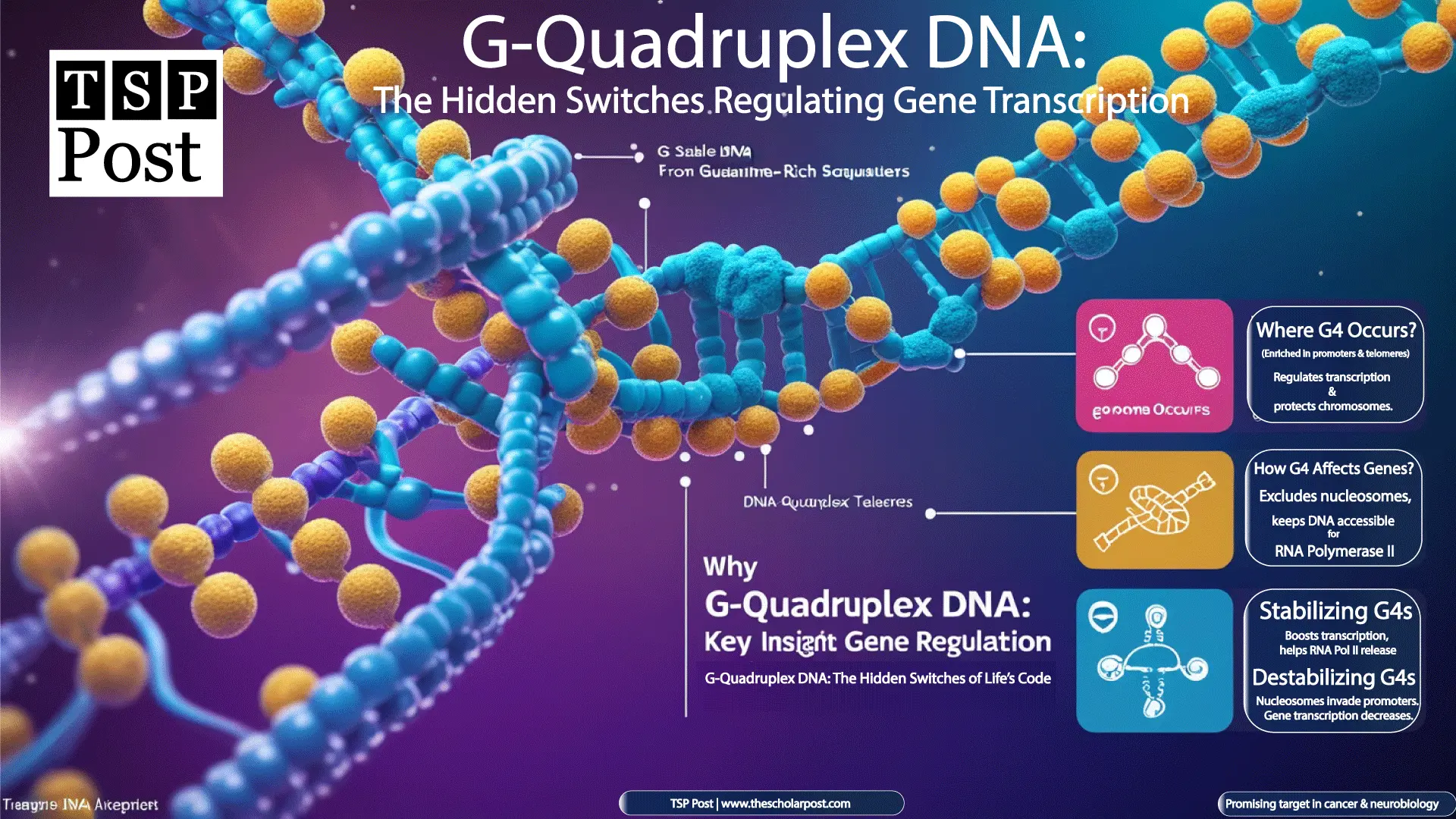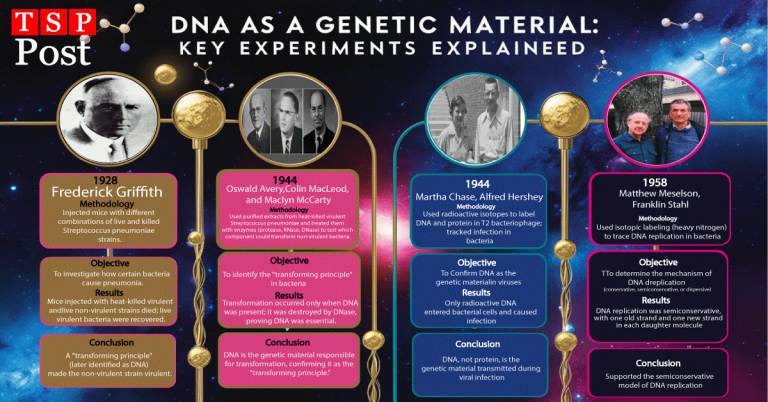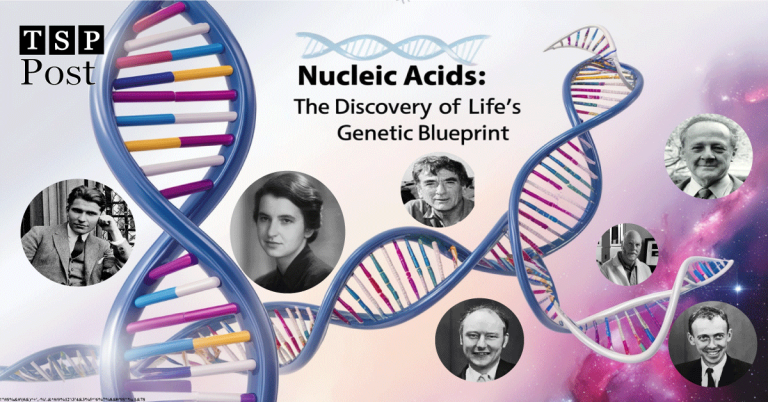G-Quadruplex DNA: The Hidden Switches Regulating Gene Transcription
Introduction: Beyond the Double Helix
For more than half a century, biology students have been taught that DNA is a double helix—a beautifully simple structure where adenine pairs with thymine and cytosine pairs with guanine. However, the genome is far more dynamic and complex than this textbook picture. DNA can twist, loop, and fold into alternative shapes that influence how genes are turned on and off. One of the most intriguing structures discovered in recent decades is the G-quadruplex DNA (G4). Specifically, these unusual four-stranded DNA arrangements form in regions where guanine bases cluster. Although long regarded as biochemical curiosities, G4s are now emerging as functional elements of gene regulation.
moreover, a groundbreaking study published in Nature Genetics in 2025 provides the strongest evidence yet: G4s act as promoter elements that control nucleosome exclusion and RNA polymerase II (Pol II) pausing, two key processes in transcription initiation.
What is the structure of Promoter? Click for details “Promoter of a Gene: Basic Structure and Function in Eukaryotic Cells“
What Exactly Are G-Quadruplexes?
A G-quadruplex forms when stretches of guanine nucleotides in DNA align in a square-planar arrangement known as a G-tetrad. Several G-tetrads stack on top of each other, stabilized by Hoogsteen hydrogen bonds and metal ions such as potassium.
These structures can appear in DNA or RNA, in both single-stranded and double-stranded contexts. They are particularly abundant in:
- Promoter regions of genes
- Telomeres, the chromosome ends that protect DNA from degradation
- Regulatory hotspots, where transcription and replication machinery assemble
Because of their stability and unique folding, G4s can block or recruit proteins, influence chromatin structure, and regulate DNA transactions.
The New Study of G-Quadruplex DNA: G4s as Promoter Elements
The research team, led by experts in genomics and chromatin biology, set out to answer a long-standing question: Are G-quadruplexes functional regulatory elements, or are they simply byproducts of guanine-rich sequences?
Using high-resolution mapping and functional genomics in mammalian cells, they discovered three critical insights:
- Active promoters enrich G4s. These DNA structures do not scatter randomly; instead, they cluster at the centers of active promoters, the genomic ‘switchboards’ that control whether genes are expressed
- G4s drive nucleosome exclusion. Nucleosomes—units of DNA wrapped around histone proteins—can physically block transcription machinery. The presence of G4s helps create nucleosome-free zones, keeping promoters accessible for transcription initiation.
- G4s regulate Pol II pausing and release. Transcription by RNA Polymerase II often involves a controlled pause near the promoter before elongation begins. G4s influence this pause, helping fine-tune when and how transcription proceeds.
Experimental Proof of G-Quadruplex DNA: Destabilize or Stabilize
To prove causation, not just correlation, the team used chemical and genetic tools to alter G4 stability.
- When G4s were destabilized:
- Promoters lost activity.
- Nucleosomes crowded into promoter regions.
- Pol II transcription dropped sharply.
- When G4s were stabilized:
- Promoters remained open.
- Nucleosome exclusion was enhanced.
- Pol II escaped pausing more effectively, boosting gene transcription.
This functional evidence confirms that G4s are essential players in promoter regulation, not accidental structures.
G-Quadruplex DNA and Its Implications in Gene Regulation
The discovery that G4s directly regulate promoters changes our view of transcription control. Traditionally, promoter activity has been explained by:
- DNA sequence motifs (like TATA boxes, enhancers, silencers)
- Histone modifications and chromatin remodeling
- Binding of transcription factors
Now, G-quadruplexes join this list as structural DNA elements that shape promoter accessibility.
This means that gene regulation is not just a matter of “which proteins bind,” but also “which DNA shapes form.”
G-Quadruplex DNA and its Links to Human Health and Disease
Because G4s are abundant in promoters, their dysfunction could contribute to disease. The new findings have direct implications for:
- Cancer biology: Many oncogenes (e.g., MYC, KRAS) contain promoter G4s. Stabilizing these structures may suppress overactive transcription, while destabilization could promote uncontrolled growth.
- Neurological disorders: Gene misregulation caused by defective G4 formation could play a role in autism, schizophrenia, and neurodegeneration.
- Drug discovery: Small molecules that stabilize or destabilize G4s are already being tested as anticancer agents. With this new understanding, they may be repurposed for broader transcription-related disorders.
G-Quadruplexes and Chromatin Dynamics
Another major insight from this study is the interplay between G4s and chromatin structure. Chromatin is often seen as a barrier that prevents transcription factors from accessing DNA. G4s, by promoting nucleosome exclusion, effectively “open the gate.”
This finding fits into a larger framework: gene activation requires both protein regulators (like transcription factors) and structural DNA regulators (like G4s). Together, they ensure that genes switch on at the right place and time.
Future Directions in Research
While this study provides convincing evidence of G4 function, many questions remain:
- Do all promoters with guanine-rich sequences form G4s, or only specific subsets?
- How do different transcription factors interact with G4s?
- Can artificial manipulation of G4s be used in gene therapy?
- Are G4s involved in epigenetic memory, influencing how promoters remain active or silent across cell divisions?
Future research combining structural biology, single-molecule imaging, and genome editing will shed light on these mysteries.
Conclusion
The discovery that G-quadruplexes function as promoter elements controlling nucleosome exclusion and RNA Polymerase II pausing represents a paradigm shift in molecular biology.
Rather than being oddities of guanine-rich DNA, G4s are integral components of the transcriptional machinery. They act as molecular switches that determine whether genes are accessible, paused, or actively transcribed.This new perspective opens exciting possibilities for medical applications, from cancer treatment to the management of transcription-related diseases.
Key Takeaways
- Guanine-rich regions form four-stranded DNA structures called G-quadruplexes (G4s).
- Active promoters enrich G4s and shape transcription.
- G4s exclude nucleosomes and regulate RNA Pol II pausing.
- Destabilizing G4s silences promoters, while stabilizing G4s boosts transcription.
- G4s may be novel therapeutic targets in cancer, neurology, and epigenetics.
G-Quadruplex DNA FAQs: Key Questions About G-Quadruplex Function in Gene Regulation
What is G-quadruplex DNA (G4)?
G-quadruplex DNA (G4) forms when four guanine-rich DNA strands stack into a stable structure. It also appears in promoter and telomere regions. Because of its shape, G4 influences gene regulation by affecting DNA accessibility.
Where do G-quadruplexes commonly occur in the genome?
G4 motifs tend to occur in active promoter regions and telomeric sequences. Therefore, they play dual roles in initiating gene transcription and protecting chromosome ends. Also, they influence chromatin structure.
How do G-quadruplexes affect gene regulation?
G4s block or exclude nucleosomes from promoters, keeping DNA accessible for RNA Polymerase II. They also regulate Pol II pausing and release. As a result, gene transcription becomes more precisely controlled.
What happens when G-quadruplexes are destabilized?
When researchers destabilize G4s, nucleosomes invade promoter regions and transcription falls. Therefore, G-quadruplexes maintain active gene expression by preserving chromatin accessibility.
Can stabilizing G-quadruplex DNA enhance transcription?
Yes—it stabilizes G4s at promoters, helps exclude nucleosomes, and eases RNA Polymerase II release. Thus, transcription increases. Also, this offers therapeutic potential for gene expression disorders.
Why is G-quadruplex DNA research important?
G4 research reveals structural DNA roles beyond sequence alone. It also opens doors to novel treatments in cancer and neurobiology by targeting gene regulation. Therefore, it adds depth to our understanding of genome function.
References/Further Reading
- Esnault, C., Zine El Aabidine, A., Robert, MC. et al. G-quadruplexes are promoter elements controlling nucleosome exclusion and RNA polymerase II pausing. Nat Genet 57, 1981–1993 (2025).https://doi.org/10.1038/s41588-025-02263-6 👉 Latest discovery showing how G-quadruplex DNA structures regulate gene activity by affecting RNA polymerase pausing.
- Varshney, D., Spiegel, J., Zyner, K. et al. The regulation and functions of DNA and RNA G-quadruplexes. Nat Rev Mol Cell Biol 21, 459–474 (2020). https://doi.org/10.1038/s41580-020-0236-x 👉 A review explaining how G-quadruplexes in both DNA and RNA influence cell functions and disease.
- Hänsel-Hertsch, R., Di Antonio, M. & Balasubramanian, S. DNA G-quadruplexes in the human genome: detection, functions and therapeutic potential. Nat Rev Mol Cell Biol 18, 279–284 (2017). https://doi.org/10.1038/nrm.2017.3 👉 Highlights methods to detect G-quadruplexes and explores their role in health and therapy.
- Daniela Rhodes, Hans J. Lipps, G-quadruplexes and their regulatory roles in biology, Nucleic Acids Research, Volume 43, Issue 18, 15 October 2015, Pages 8627–8637, https://doi.org/10.1093/nar/gkv862 👉 Explains how G-quadruplexes control biological processes such as replication, transcription, and genome stability.
- Chambers, V., Marsico, G., Boutell, J. et al. High-throughput sequencing of DNA G-quadruplex structures in the human genome. Nat Biotechnol 33, 877–881 (2015). https://doi.org/10.1038/nbt.3295 👉 First large-scale study mapping thousands of G-quadruplexes across the human genome.





